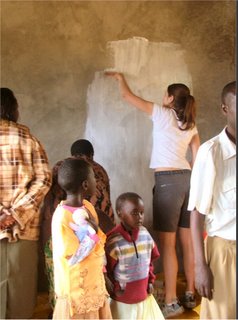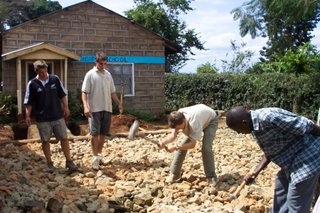Young Leader in successful Alp’s venture

 The DES is always looking to encourage young leaders to fulfil their potential, that is why we spend so much time, effort and money on training young people to gain the right experience and qualifications.
The DES is always looking to encourage young leaders to fulfil their potential, that is why we spend so much time, effort and money on training young people to gain the right experience and qualifications.James Thompson is yet another credit to the DES; his recent trip to Chamonix was a huge success. Read more on what the trip entailed...
Need training to lead your own trip? Contact Keith in the DES office for help and advice.
email: admin@leadingedge.org.uk
-----------------------------------------------------------------------------------------
Chamonix 2007: James Thompson, Chris Garrett, Richard Brelsford, Charlie Major
Once we arrived in Geneva we caught our mini bus to Chamonix and got ourselves settled at the Camping de la Argentiere campsite, just outside of Argentiere. We got up to date weather forecasts and route conditions, which were all superb up until Wednesday. It was an early finish for us all that evening, getting packed up and ready for an early start hitting the Tour De Glace tomorrow.
On Saturday, we left the camp site at 6.30am and walked up to Le Tour . It took us three hours to reach the refuge at 2700m’s .and the superb views of the Table de Roc and the Chardonet across the glacier. We then headed down to the Tour De Glace, which was a new experience for group members, and went through all the necessary skills for Glacier travel; crampon and ice axe skills to crevasse rescue and set ups. The descent took us two and a half hours and when arriving we were just in time to catch the bus back to the camp site, which I think the team was thankful of. That evening we sat back and relaxed at the camp site, cooking up dinner and going through the plans for tomorrow’s adventures on the Mer De Glace.
The main navigation problems on the trip came about on day two. We were keeping our eyes open whilst walking down the Glacier descent path for that right turn that takes you directly down to the Glacier, not down to the Ice Caves! Once on the right track the path changed into a series of ladders taking us down about 200 metres to the glacier.
The main training for the Mer de Glace was moving together when roped up, which took
us all the way up to the end of the Mer de Glace at the Les Chaux/Glace de Tacul joining point which was a grand lunch spot. During the descent back down the Glacier, the team practiced some more rescue techniques. This was followed by a couple of ice climbing sessions on some of the more easily accessible crevasses, which everyone got on really well with and I think started some new sport bugs. The lads were very keen for getting on some Via Ferrata routes during this expedition, so the climb back out the Glacier using all the ladders and foot pegs was much liked by all of them.
The Refuge was very busy due to a lot of companies bringing clients for training and acclimatising for their planned Mont Blanc trips.
Tuesday morning. We walked across the rocks to the glacier for as far as we could and then all had to get roped up and crampons and ice axes out.. As we approached the Signal Reilly, across some of the steeper terrain, everyone continued straight on but our ‘recky’ and navigation told us that for the traverse we had to head off North West under the mountain. After a quick thought web decided to go ahead with what we thought, trust our own navigation, which took us across some fresh terrain and the only people to ascend the mountain via this route. The route then traversed right under the mountain until we reached a small col that we had to climb up and over to get on the Plateau du Trient. Once on the Plateau we were exposed to all the winds which really dropped the temperature. From there the traverse continued across the West side of the mountain and across some great terrain with a mixture of good exposure, sustained steeper sections and some interesting crevasses and old snow bridges to cross. When moving across the Glacier a few groups members had some concerned thoughts and things to say about the noises coming from it from under there feet, and after explaining that it was the ice moving and cracking weren’t convinced we were on the right path!
Once we got round the mountain we were soon out of the wind and things became a lot quieter.
By the time we reached the final section on the climb, up to the summit of the Aiguille du Tour South Peak, most of the other parties were on there way back down. The final section crossed a fairly simple Bergschrund, traverse across to all the rocks and scree and then from there crampons and axes can be left and it’s a 30 minute scramble up to the summit, which luckily we had all to ourselves. The fellers were all really made up with reaching there first alpine summit and also how blessed with the weather we had been. After climbing back down to where we had left kit, then crossing the Bergschrund we made our way back down to the Tour de Glace via the Normal ascent route of the Aiguille du Tour.
The following day our routes were up the Tete Blanche and then Petite Farche. This involved a scramble with some steeper more exposed sections and the final part of the ridge involved a couple of patches of ice to climb whish gave the route some great variety. The climb of Petite Farche from the summit of Tete Blanche was fairly simple and just involved a short traverse with very little height loss and then a steep 150m face of snow to climb followed by a short scramble to the summit. Both summits gave brilliantly clear panoramic views of the surrounding mountains and glaciers. From the summit of Petite Farche it took us under 1hour 30min to walk back down to the Albert refuge, traversing down just east of the Col Du Tour. Later that afternoon we began our descent back down to the valley via the West ridge. Descent was very sharp, 1hour 10min back down to Le Tour.
Thursday’s route started off by crossing the Glacier and then climbing a series of ladders to take us onto a track above the Glacier. The route lead us across the lower section of the La Charpoua Glacier and refuge and then traversed round until we were above the Leschaux Glacier and finishing our traverse at the Courvcle hut. After lunch we then began our descent back down to the end of the Mer de Glace, which like the ascent involved a lot of long ladders, foot pegs and metal platforms which were bolted to the rock face. On reaching the Glacier we had to walk from the Tacul/Leschaux joining point back down to the train station at the top of the lower end of the Mer de Glace. The route was a brilliant alpine walk, reaching a highest point of 2700m. The day’s route was listed as being a two day trek, but with an early start can be comfortably done in a single day and took us around eight hours to complete. Not much of a via ferrata route, as many guide books do list it, but a very enjoyable alpine trek.
On our final full day in Chamonix we had plans to do a Via Ferrata route known as Via Ferrata La Tour du Jalouvre. The route took us on a 5 hour round trip and offered a good mixture of both natural and aided climbing. Some sections of the route involved very steep and long ladder systems, sometimes over-hanging. Once higher up on the route we had several bridges to cross including a 16m suspension bridge.
James Thompson













